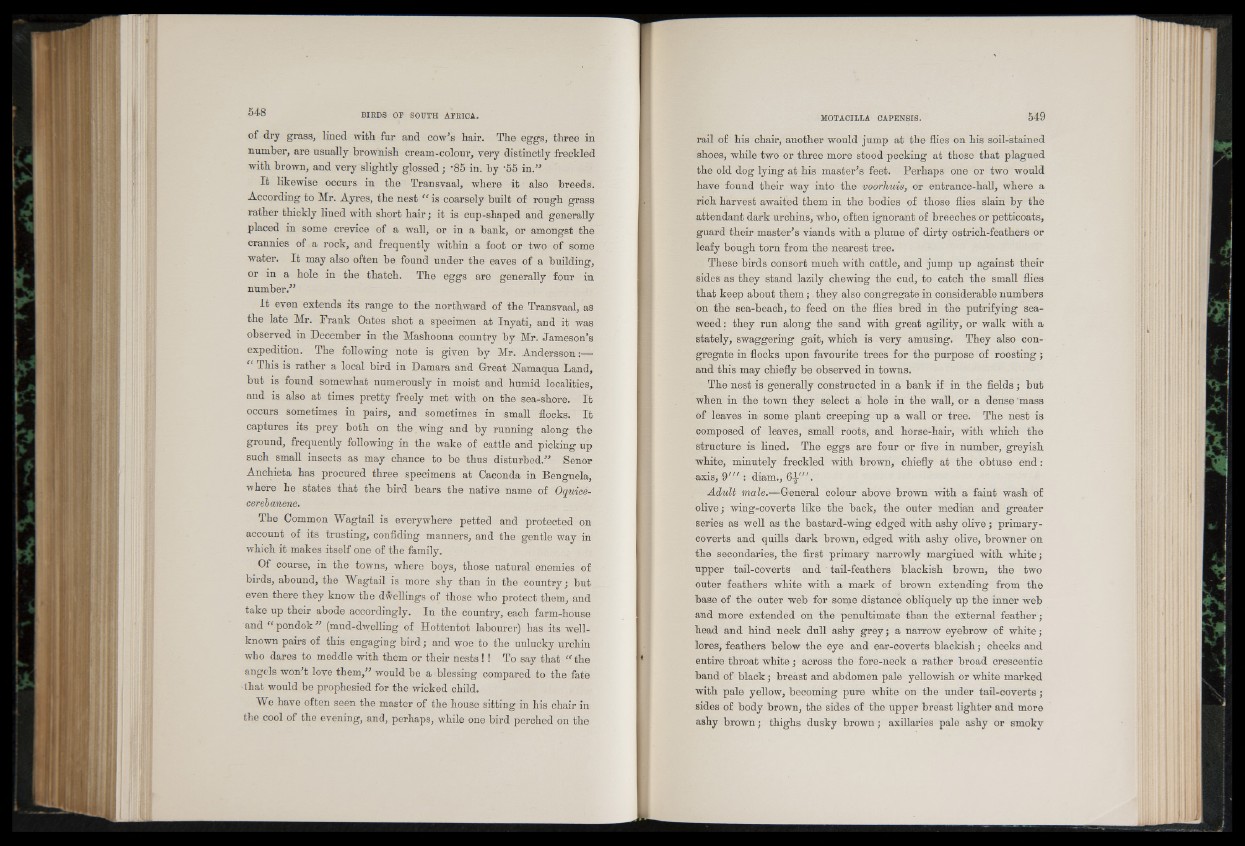
of dry grass, lined with, fur and cow’s hair. The eggs, three in
number, are usually brownish cream-colour, very distinctly freckled
with brown, and very slightly glossed; -85 in. by -55 in.”
It likewise occurs in the Transvaal, where it also breeds.
According to Mr. Ayres, the nest “ is coarsely built of rough grass
rather thickly lined with short hair; it is cup-shaped and generally
placed in some crevice of a wall, or in a bank, or amongst the
crannies of a rock, and frequently within a foot or two of some
water. It may also often be found under the eaves of a building,
or in a hole in the thatch. The eggs are generally four in
number.”
I t even extends its range to the northward of the Transvaal, as
the late Mr. Frank Oates shot a specimen at Inyati, and it was
observed in December in the Mashoona country by Mr. Jameson’s
expedition. The following note is given by Mr. Andersson:—
This is rather a local bird in Damara and Great Namaqua Land,
but is found somewhat numerously in moist and humid localities,
and is also at times pretty freely met with on the sea-shore. It
occurs sometimes in pairs, and sometimes in small flocks. It
captures its prey both on the wing and by running along the
ground, frequently following in the wake of cattle and picking up
such small insects as may chance to be thus disturbed.” Senor
Anchieta has procured three specimens at Caconda in Benguela,
where he states that the bird bears the native name of Oqwice-
cerebanene.
The Common Wagtail is everywhere petted and protected on
account of its trusting, confiding manners, and the gentle way in
which it makes itself one of the family.
Of course, in the towns, where boys, those natural enemies of
birds, abound, the Wagtail is more shy than in the country; but
even there they know the dwellings of those who protect them, and
take up their abode accordingly. Iu the country, each farm-house
and “ pondok ” (mud-dwelling of Hottentot labourer) has its well-
known pairs of this engaging bird; and woe to the unlucky urchin
who dares to meddle with them or their nests ! ! To say that “ the
angels won’t love them,” would be a blessing compared to the fate
that would be prophesied for the wicked child.
We have often seen the master of the house sitting in his chair in
the cool of the evening, and, perhaps, while one bird perched on the
rail of his chair, another would jump at the flies on his soil-stained
shoes, while two or three more stood pecking at those that plagued
the old dog lying at his master’s feet. Perhaps one or two would
have found their way into the voorTmis, or entrance-hall, where a
rich harvest awaited them in the bodies of those flies slain by the
attendant dark urchins, who, often ignorant of breeches or petticoats,
guard their master’s viands with a plume of dirty ostrich-feathers or
leafy bough torn from the nearest tree.
These birds consort much with cattle, and jump up against their
sides as they stand lazily chewing the cud, to catch the small flies
that keep about them; they also congregate in considerable numbers
on the sea-beach, to feed on the flies bred in the putrifying seaweed
: they run along the sand with great agility, or walk with a
stately, swaggering gait, which is very amusing. They also congregate
in flocks upon favourite trees for the purpose of roosting;
and this may chiefly be observed in towns.
The nest is generally constructed in a bank if in the fields; but
when in the town they select a hole in the wall, or a dense'mass
of leaves in some plant creeping up a wall or tree. The nest is
composed of leaves, small roots, and horse-hair, with which the
structure is lined. The eggs are four or five in number, greyish
white, minutely freckled with brown, chiefly at the obtuse end:
axis, 9 '" : diam., 61” '.
Adult male.—General colour above brown with a faint wash of
olive; wing-coverts like the back, the outer median and greater
series as well as the bastard-wing edged with ashy olive; primary -
coverts and quills dark brown, edged with ashy olive, browner on
the secondaries, the first primary narrowly margined with white;
upper tail-coverts and tail-feathers blackish brown, the two
outer feathers white with a mark of brown extending from the
base of the outer web for some distance obliquely up the inner web
and more extended on the penultimate than the external feather;
head and hind neck dull ashy grey; a narrow eyebrow of white;
lores, feathers below the eye and ear-coverts blackish; cheeks and
entire throat white; across the fore-neck a rather broad crescentic
band of black; breast and abdomen pale yellowish or white marked
with pale yellow, becoming pure white on the under tail-coverts;
sides of body brown, the sides of the upper breast lighter and more
ashy brown; thighs dusky brown; axillaries pale ashy or smoky